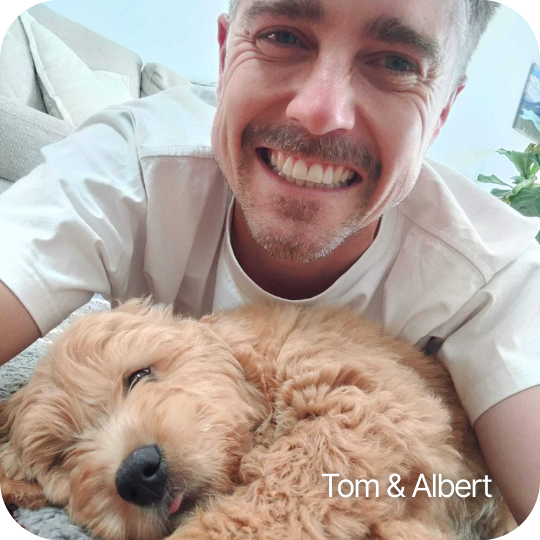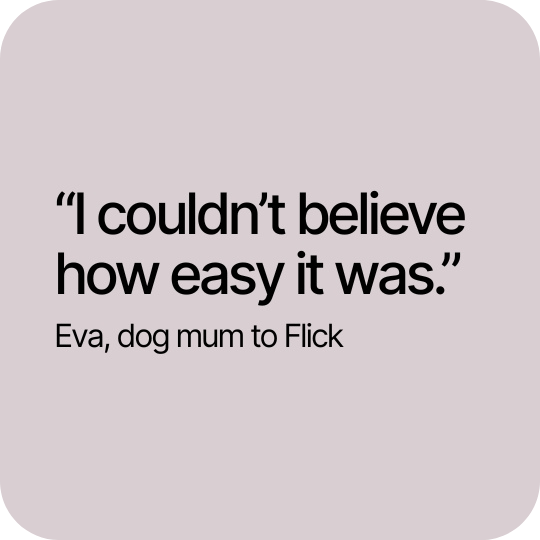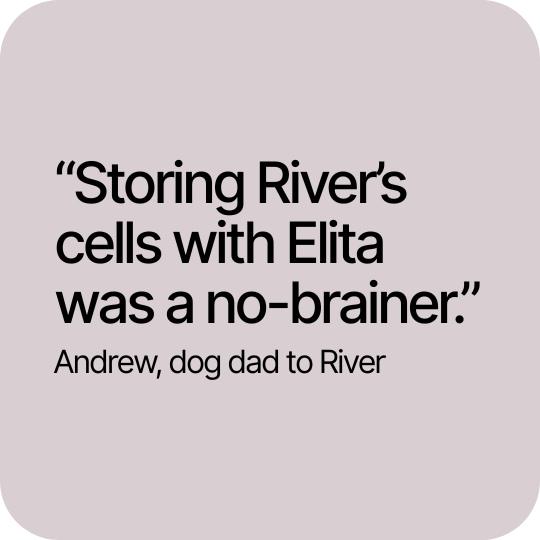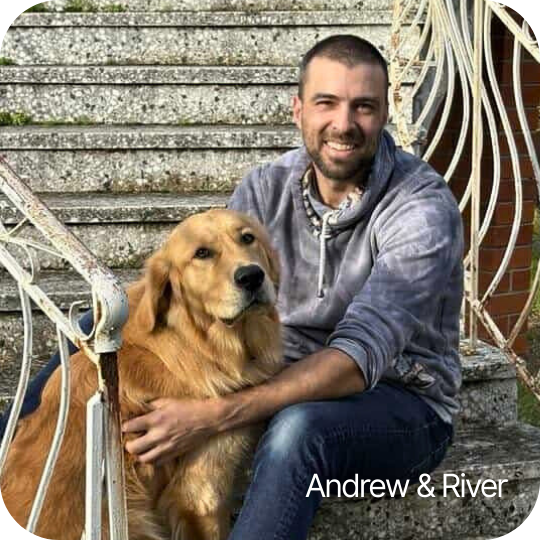Turning biological data into more good years
.png)
Stop guessing.
Start preventing.
By tracking trends over time, Elita spots the early signs of problems long before they become emergencies, helping you to optimise their health, prevent disease and stay ahead of problems before they show up. Elita doesn't just track appointments; it builds a living picture of your pet's biology.
We unify every layer of health, from clinical records to owner observations and biological markers, transforming fragmented notes into a clear, science-backed Blueprint.
How it works
Step 1
Create their Blueprint

Sign up to Elita Blueprint and complete the Dynamic Health Intake to create your pet's personalised health profile.

We start by focusing on key areas of their history and lifestyle.
Step 2
Concierge your records

We concierge your pet's medical history, actively working to unify all clinical records into their profile.

Their historical clinical data, combined with owner observations, builds the intelligent engine specific to their biology.

(Coming Soon)
Simple at-home tests will let you add deeper biological insights to your dog’s Blueprint, all without a clinic visit.
Step 3
Gain the Blueprint

The result is a complete, living picture of their health.

The system delivers predictive insights, personalised recommendations, and dynamic care actions to guide you.

Gain access to advanced health support tooling, enabling faster, easier care.

Putting their health back in your hands enabling you to make proactive, better decisions for more good years, together.
The infrastructure for longevity
We unify every layer of your pet’s health, clinical records, biological markers, and daily habits, into one intelligent, always-updated picture. Elita works quietly in the background, turning complex biology into clear, actionable guidance so you can focus on giving them more good years.
Founded by owners
We started Elita because we wanted better control of our own dog, Edgar's health. This passion fuels the platform's direction, but the delivery is science-first: our in-house team of vets, PhD scientists, and biomedical engineers transform that owner motivation into validated clinical insights and preventative actions.

.png)
Advanced diagnostics,
at home
Our dedicated Australian laboratory analyses advanced diagnostics to better understand your pet's full biology. This local infrastructure can capture significantly more biological information than is available through general practice alone.
See the impact of every decision
Elita connects the dots between daily inputs and long-term health. Watch how changes in diet and lifestyle improve body condition and directly reduce joint load and disease risk, turning invisible biological shifts into visible progress.
.png)
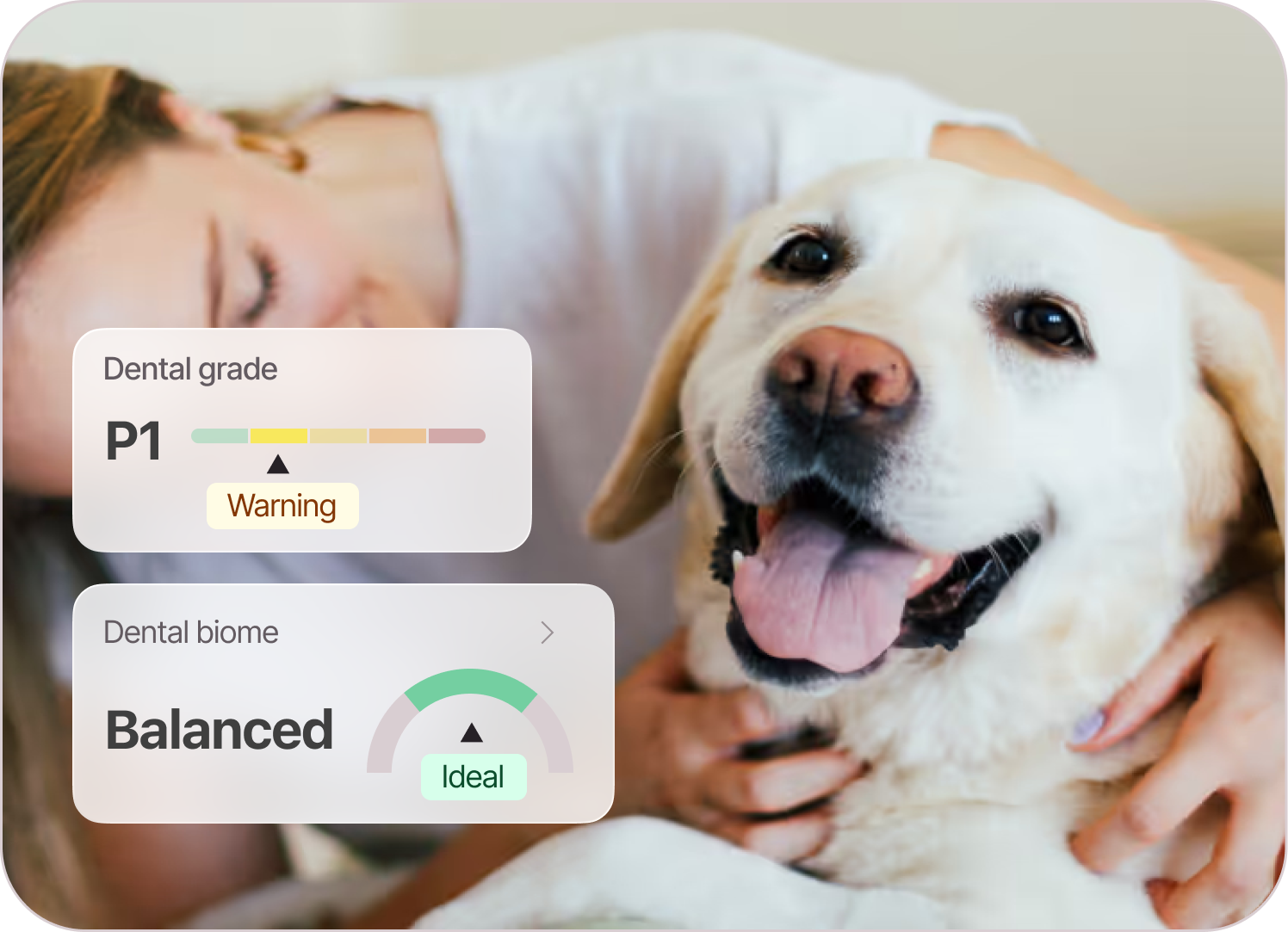
Health data, simplified
Complex pathology, unique biomarkers, and owner observations are transformed into a clear, simple Blueprint. We turn raw, confusing data into actionable guidance, telling you exactly what you need to know, early to enable prevention.
FAQs
FAQs
Why isn't the app on the Apple or Google Play store?
.svg)

We launched Elita as a Progressive Web App (PWA). This allows us to build and update features much faster than traditional app stores allow.
You can save the app directly to your home screen and it acts just like a native app. Your phone will guide you on how to do this when you sign up, or you can get step-by-step instructions on how to download a PWA here.
What is the Stem Cell Biobank, and is it right for my dog?
.svg)

Elita's biobank is a part of our longevity interventions. Banking your pet's healthy cells is the ultimate form of biological insurance. It involves collecting a small sample of your dog’s healthy tissue (often during a routine procedure like desexing) and cryopreserving it.
These cells are the raw material for personalised therapies treating arthritis and age-related decline. Banking them while your dog is young and healthy 'stops the clock' on their biology, securing access to powerful, personalised treatments for their future self.
This is game changing for pets who are predisposed to issues, have shown early signs of dysplasia, have had a cruciate ligament tear and a host of other illnesses. Read more about stem cell banking and if it's right for your dog here.
Why is "biological data" so important for my dog?
.svg)

Because dogs are experts at hiding pain, and every dog is unique. There are countless factors that impact your dog, from breed to age, environment and everything in between.
Biological data means you are not making decisions based on any dog, you are doing it based on your dog. This reveals the 'silent signals' of ageing and disease long before symptoms appear.
We are the only preventative health platform in the world that marries in-house Lab data with an easy-to-use digital platform, giving you the power to spot issues early and secure more good years together.
How does the "Record Concierge" work?
.svg)

We do the heavy lifting so you don't have to. Instead of simply collecting PDFs, our team contacts your vets to run a full analysis across your pet's total health overview.
We unify scattered history into one secure Data Vault, digitising and organising every clinical note. Guided by our in-house clinical team, we turn raw, fragmented data into clear, interpreted outputs. This gives you and any future specialist you visit a single, clear source of truth for your dog's entire medical life.
Is this just a calendar for reminders?
.svg)

No. A calendar tells you when to do something; Elita tells you why it matters and what to look for next.We are a longevity platform. While we do track vaccinations and appointments, our core engine audits your pet's medical history, tracks over 100+ biomarkers, and monitors lifestyle trends. We move beyond simple "to-do" lists to build a living biological profile that helps you prevent disease, not just schedule it.
Do I still need to see a vet if I use Blueprint?
.svg)

Absolutely. Your vet is your dog’s surgeon, dentist, and emergency hero. Blueprint doesn’t replace them; it powers them.Most vets only see your pet for 15 minutes a year, often when they are already stressed or sick. Blueprint captures the other 99% of their life—trends, habits, and silent signalsgiving your vet the full data picture they need to make faster, better diagnoses. It turns a standard consult into a proactive health strategy.
Understanding Stem Cell Banking
Heading
.svg)

Heading 1
Heading 2
Heading 3
Heading 4
Heading 5
Heading 6
Lorem ipsum dolor sit amet, consectetur adipiscing elit, sed do eiusmod tempor incididunt ut labore et dolore magna aliqua. Ut enim ad minim veniam, quis nostrud exercitation ullamco laboris nisi ut aliquip ex ea commodo consequat. Duis aute irure dolor in reprehenderit in voluptate velit esse cillum dolore eu fugiat nulla pariatur.
Block quote
Ordered list
- Item 1
- Item 2
- Item 3
Unordered list
- Item A
- Item B
- Item C
Bold text
Emphasis
Superscript
Subscript
Heading
.svg)

Heading 1
Heading 2
Heading 3
Heading 4
Heading 5
Heading 6
Lorem ipsum dolor sit amet, consectetur adipiscing elit, sed do eiusmod tempor incididunt ut labore et dolore magna aliqua. Ut enim ad minim veniam, quis nostrud exercitation ullamco laboris nisi ut aliquip ex ea commodo consequat. Duis aute irure dolor in reprehenderit in voluptate velit esse cillum dolore eu fugiat nulla pariatur.
Block quote
Ordered list
- Item 1
- Item 2
- Item 3
Unordered list
- Item A
- Item B
- Item C
Bold text
Emphasis
Superscript
Subscript
Heading
.svg)

Heading 1
Heading 2
Heading 3
Heading 4
Heading 5
Heading 6
Lorem ipsum dolor sit amet, consectetur adipiscing elit, sed do eiusmod tempor incididunt ut labore et dolore magna aliqua. Ut enim ad minim veniam, quis nostrud exercitation ullamco laboris nisi ut aliquip ex ea commodo consequat. Duis aute irure dolor in reprehenderit in voluptate velit esse cillum dolore eu fugiat nulla pariatur.
Block quote
Ordered list
- Item 1
- Item 2
- Item 3
Unordered list
- Item A
- Item B
- Item C
Bold text
Emphasis
Superscript
Subscript
Heading
.svg)

Heading 1
Heading 2
Heading 3
Heading 4
Heading 5
Heading 6
Lorem ipsum dolor sit amet, consectetur adipiscing elit, sed do eiusmod tempor incididunt ut labore et dolore magna aliqua. Ut enim ad minim veniam, quis nostrud exercitation ullamco laboris nisi ut aliquip ex ea commodo consequat. Duis aute irure dolor in reprehenderit in voluptate velit esse cillum dolore eu fugiat nulla pariatur.
Block quote
Ordered list
- Item 1
- Item 2
- Item 3
Unordered list
- Item A
- Item B
- Item C
Bold text
Emphasis
Superscript
Subscript
Heading
.svg)

Heading 1
Heading 2
Heading 3
Heading 4
Heading 5
Heading 6
Lorem ipsum dolor sit amet, consectetur adipiscing elit, sed do eiusmod tempor incididunt ut labore et dolore magna aliqua. Ut enim ad minim veniam, quis nostrud exercitation ullamco laboris nisi ut aliquip ex ea commodo consequat. Duis aute irure dolor in reprehenderit in voluptate velit esse cillum dolore eu fugiat nulla pariatur.
Block quote
Ordered list
- Item 1
- Item 2
- Item 3
Unordered list
- Item A
- Item B
- Item C
Bold text
Emphasis
Superscript
Subscript
Heading
.svg)

Heading 1
Heading 2
Heading 3
Heading 4
Heading 5
Heading 6
Lorem ipsum dolor sit amet, consectetur adipiscing elit, sed do eiusmod tempor incididunt ut labore et dolore magna aliqua. Ut enim ad minim veniam, quis nostrud exercitation ullamco laboris nisi ut aliquip ex ea commodo consequat. Duis aute irure dolor in reprehenderit in voluptate velit esse cillum dolore eu fugiat nulla pariatur.
Block quote
Ordered list
- Item 1
- Item 2
- Item 3
Unordered list
- Item A
- Item B
- Item C
Bold text
Emphasis
Superscript
Subscript
Heading
.svg)

Heading 1
Heading 2
Heading 3
Heading 4
Heading 5
Heading 6
Lorem ipsum dolor sit amet, consectetur adipiscing elit, sed do eiusmod tempor incididunt ut labore et dolore magna aliqua. Ut enim ad minim veniam, quis nostrud exercitation ullamco laboris nisi ut aliquip ex ea commodo consequat. Duis aute irure dolor in reprehenderit in voluptate velit esse cillum dolore eu fugiat nulla pariatur.
Block quote
Ordered list
- Item 1
- Item 2
- Item 3
Unordered list
- Item A
- Item B
- Item C
Bold text
Emphasis
Superscript
Subscript
Clinical FAQs
Heading
.svg)

Heading 1
Heading 2
Heading 3
Heading 4
Heading 5
Heading 6
Lorem ipsum dolor sit amet, consectetur adipiscing elit, sed do eiusmod tempor incididunt ut labore et dolore magna aliqua. Ut enim ad minim veniam, quis nostrud exercitation ullamco laboris nisi ut aliquip ex ea commodo consequat. Duis aute irure dolor in reprehenderit in voluptate velit esse cillum dolore eu fugiat nulla pariatur.
Block quote
Ordered list
- Item 1
- Item 2
- Item 3
Unordered list
- Item A
- Item B
- Item C
Bold text
Emphasis
Superscript
Subscript
Heading
.svg)

Heading 1
Heading 2
Heading 3
Heading 4
Heading 5
Heading 6
Lorem ipsum dolor sit amet, consectetur adipiscing elit, sed do eiusmod tempor incididunt ut labore et dolore magna aliqua. Ut enim ad minim veniam, quis nostrud exercitation ullamco laboris nisi ut aliquip ex ea commodo consequat. Duis aute irure dolor in reprehenderit in voluptate velit esse cillum dolore eu fugiat nulla pariatur.
Block quote
Ordered list
- Item 1
- Item 2
- Item 3
Unordered list
- Item A
- Item B
- Item C
Bold text
Emphasis
Superscript
Subscript
Heading
.svg)

Heading 1
Heading 2
Heading 3
Heading 4
Heading 5
Heading 6
Lorem ipsum dolor sit amet, consectetur adipiscing elit, sed do eiusmod tempor incididunt ut labore et dolore magna aliqua. Ut enim ad minim veniam, quis nostrud exercitation ullamco laboris nisi ut aliquip ex ea commodo consequat. Duis aute irure dolor in reprehenderit in voluptate velit esse cillum dolore eu fugiat nulla pariatur.
Block quote
Ordered list
- Item 1
- Item 2
- Item 3
Unordered list
- Item A
- Item B
- Item C
Bold text
Emphasis
Superscript
Subscript
Heading
.svg)

Heading 1
Heading 2
Heading 3
Heading 4
Heading 5
Heading 6
Lorem ipsum dolor sit amet, consectetur adipiscing elit, sed do eiusmod tempor incididunt ut labore et dolore magna aliqua. Ut enim ad minim veniam, quis nostrud exercitation ullamco laboris nisi ut aliquip ex ea commodo consequat. Duis aute irure dolor in reprehenderit in voluptate velit esse cillum dolore eu fugiat nulla pariatur.
Block quote
Ordered list
- Item 1
- Item 2
- Item 3
Unordered list
- Item A
- Item B
- Item C
Bold text
Emphasis
Superscript
Subscript
Heading
.svg)

Heading 1
Heading 2
Heading 3
Heading 4
Heading 5
Heading 6
Lorem ipsum dolor sit amet, consectetur adipiscing elit, sed do eiusmod tempor incididunt ut labore et dolore magna aliqua. Ut enim ad minim veniam, quis nostrud exercitation ullamco laboris nisi ut aliquip ex ea commodo consequat. Duis aute irure dolor in reprehenderit in voluptate velit esse cillum dolore eu fugiat nulla pariatur.
Block quote
Ordered list
- Item 1
- Item 2
- Item 3
Unordered list
- Item A
- Item B
- Item C
Bold text
Emphasis
Superscript
Subscript
Heading
.svg)

Heading 1
Heading 2
Heading 3
Heading 4
Heading 5
Heading 6
Lorem ipsum dolor sit amet, consectetur adipiscing elit, sed do eiusmod tempor incididunt ut labore et dolore magna aliqua. Ut enim ad minim veniam, quis nostrud exercitation ullamco laboris nisi ut aliquip ex ea commodo consequat. Duis aute irure dolor in reprehenderit in voluptate velit esse cillum dolore eu fugiat nulla pariatur.
Block quote
Ordered list
- Item 1
- Item 2
- Item 3
Unordered list
- Item A
- Item B
- Item C
Bold text
Emphasis
Superscript
Subscript
Heading
.svg)

Heading 1
Heading 2
Heading 3
Heading 4
Heading 5
Heading 6
Lorem ipsum dolor sit amet, consectetur adipiscing elit, sed do eiusmod tempor incididunt ut labore et dolore magna aliqua. Ut enim ad minim veniam, quis nostrud exercitation ullamco laboris nisi ut aliquip ex ea commodo consequat. Duis aute irure dolor in reprehenderit in voluptate velit esse cillum dolore eu fugiat nulla pariatur.
Block quote
Ordered list
- Item 1
- Item 2
- Item 3
Unordered list
- Item A
- Item B
- Item C
Bold text
Emphasis
Superscript
Subscript
Heading
.svg)

Heading 1
Heading 2
Heading 3
Heading 4
Heading 5
Heading 6
Lorem ipsum dolor sit amet, consectetur adipiscing elit, sed do eiusmod tempor incididunt ut labore et dolore magna aliqua. Ut enim ad minim veniam, quis nostrud exercitation ullamco laboris nisi ut aliquip ex ea commodo consequat. Duis aute irure dolor in reprehenderit in voluptate velit esse cillum dolore eu fugiat nulla pariatur.
Block quote
Ordered list
- Item 1
- Item 2
- Item 3
Unordered list
- Item A
- Item B
- Item C
Bold text
Emphasis
Superscript
Subscript
Heading
.svg)

Heading 1
Heading 2
Heading 3
Heading 4
Heading 5
Heading 6
Lorem ipsum dolor sit amet, consectetur adipiscing elit, sed do eiusmod tempor incididunt ut labore et dolore magna aliqua. Ut enim ad minim veniam, quis nostrud exercitation ullamco laboris nisi ut aliquip ex ea commodo consequat. Duis aute irure dolor in reprehenderit in voluptate velit esse cillum dolore eu fugiat nulla pariatur.
Block quote
Ordered list
- Item 1
- Item 2
- Item 3
Unordered list
- Item A
- Item B
- Item C
Bold text
Emphasis
Superscript
Subscript
Heading
.svg)

Heading 1
Heading 2
Heading 3
Heading 4
Heading 5
Heading 6
Lorem ipsum dolor sit amet, consectetur adipiscing elit, sed do eiusmod tempor incididunt ut labore et dolore magna aliqua. Ut enim ad minim veniam, quis nostrud exercitation ullamco laboris nisi ut aliquip ex ea commodo consequat. Duis aute irure dolor in reprehenderit in voluptate velit esse cillum dolore eu fugiat nulla pariatur.
Block quote
Ordered list
- Item 1
- Item 2
- Item 3
Unordered list
- Item A
- Item B
- Item C
Bold text
Emphasis
Superscript
Subscript
Heading
.svg)

Heading 1
Heading 2
Heading 3
Heading 4
Heading 5
Heading 6
Lorem ipsum dolor sit amet, consectetur adipiscing elit, sed do eiusmod tempor incididunt ut labore et dolore magna aliqua. Ut enim ad minim veniam, quis nostrud exercitation ullamco laboris nisi ut aliquip ex ea commodo consequat. Duis aute irure dolor in reprehenderit in voluptate velit esse cillum dolore eu fugiat nulla pariatur.
Block quote
Ordered list
- Item 1
- Item 2
- Item 3
Unordered list
- Item A
- Item B
- Item C
Bold text
Emphasis
Superscript
Subscript
Heading
.svg)

Heading 1
Heading 2
Heading 3
Heading 4
Heading 5
Heading 6
Lorem ipsum dolor sit amet, consectetur adipiscing elit, sed do eiusmod tempor incididunt ut labore et dolore magna aliqua. Ut enim ad minim veniam, quis nostrud exercitation ullamco laboris nisi ut aliquip ex ea commodo consequat. Duis aute irure dolor in reprehenderit in voluptate velit esse cillum dolore eu fugiat nulla pariatur.
Block quote
Ordered list
- Item 1
- Item 2
- Item 3
Unordered list
- Item A
- Item B
- Item C
Bold text
Emphasis
Superscript
Subscript
Heading
.svg)

Heading 1
Heading 2
Heading 3
Heading 4
Heading 5
Heading 6
Lorem ipsum dolor sit amet, consectetur adipiscing elit, sed do eiusmod tempor incididunt ut labore et dolore magna aliqua. Ut enim ad minim veniam, quis nostrud exercitation ullamco laboris nisi ut aliquip ex ea commodo consequat. Duis aute irure dolor in reprehenderit in voluptate velit esse cillum dolore eu fugiat nulla pariatur.
Block quote
Ordered list
- Item 1
- Item 2
- Item 3
Unordered list
- Item A
- Item B
- Item C
Bold text
Emphasis
Superscript
Subscript
Getting Started & What to Expect
Heading
.svg)

Heading 1
Heading 2
Heading 3
Heading 4
Heading 5
Heading 6
Lorem ipsum dolor sit amet, consectetur adipiscing elit, sed do eiusmod tempor incididunt ut labore et dolore magna aliqua. Ut enim ad minim veniam, quis nostrud exercitation ullamco laboris nisi ut aliquip ex ea commodo consequat. Duis aute irure dolor in reprehenderit in voluptate velit esse cillum dolore eu fugiat nulla pariatur.
Block quote
Ordered list
- Item 1
- Item 2
- Item 3
Unordered list
- Item A
- Item B
- Item C
Bold text
Emphasis
Superscript
Subscript
Heading
.svg)

Heading 1
Heading 2
Heading 3
Heading 4
Heading 5
Heading 6
Lorem ipsum dolor sit amet, consectetur adipiscing elit, sed do eiusmod tempor incididunt ut labore et dolore magna aliqua. Ut enim ad minim veniam, quis nostrud exercitation ullamco laboris nisi ut aliquip ex ea commodo consequat. Duis aute irure dolor in reprehenderit in voluptate velit esse cillum dolore eu fugiat nulla pariatur.
Block quote
Ordered list
- Item 1
- Item 2
- Item 3
Unordered list
- Item A
- Item B
- Item C
Bold text
Emphasis
Superscript
Subscript
Heading
.svg)

Heading 1
Heading 2
Heading 3
Heading 4
Heading 5
Heading 6
Lorem ipsum dolor sit amet, consectetur adipiscing elit, sed do eiusmod tempor incididunt ut labore et dolore magna aliqua. Ut enim ad minim veniam, quis nostrud exercitation ullamco laboris nisi ut aliquip ex ea commodo consequat. Duis aute irure dolor in reprehenderit in voluptate velit esse cillum dolore eu fugiat nulla pariatur.
Block quote
Ordered list
- Item 1
- Item 2
- Item 3
Unordered list
- Item A
- Item B
- Item C
Bold text
Emphasis
Superscript
Subscript
Heading
.svg)

Heading 1
Heading 2
Heading 3
Heading 4
Heading 5
Heading 6
Lorem ipsum dolor sit amet, consectetur adipiscing elit, sed do eiusmod tempor incididunt ut labore et dolore magna aliqua. Ut enim ad minim veniam, quis nostrud exercitation ullamco laboris nisi ut aliquip ex ea commodo consequat. Duis aute irure dolor in reprehenderit in voluptate velit esse cillum dolore eu fugiat nulla pariatur.
Block quote
Ordered list
- Item 1
- Item 2
- Item 3
Unordered list
- Item A
- Item B
- Item C
Bold text
Emphasis
Superscript
Subscript
Where biology meets technology, to power your dog’s complete health platform
Blueprint is your dog’s digital health hub, connecting vet data, biology and preventative care in one trusted place. Supercharge your dog’s health insights by adding our longevity interventions.
.avif)
Store today, protect tomorrow.
Banking your dog’s stem cells gives you more options when they need them most; for arthritis, joint pain, injury recovery, and beyond. One simple step today gives your vet everything they need to keep your dog active, mobile, and pain-free for years to come.
Why store your pet's stem cells?
Banking your pet’s stem cells gives your vet more options to treat common health issues, such as arthritis, joint and muscular conditions, now or in future. Instead of harsh drugs or invasive surgeries with long recovery periods, you can act sooner using stem cell treatment to relieve pain and restore mobility.
Stem cell banking unlocks these treatments now and will give your pet access to more world-class treatments as they’re developed for conditions such as kidney disease, heart disease and more. It gives you more choices for better treatments now, and helps you prevent disease and pain through early detection and intervention.
How it works
By banking your pet’s stem cells, you’ll never need to worry if you could have done more to prevent pain and suffering, and enjoy more good years together.
Stem cell retrieval
It’s simple to retrieve your pet’s stem cells during a routine procedure at your vet, such as desexing or teeth cleaning. Simply register with us beforehand, let your vet know and we’ll take care of the rest.

Stem cell banking
Your pet’s stem cells are safely stored in our secure stem cell bank, ready for treatment whenever they’re needed. We can also alert you to changes in stem cell health over time, so you can act early to prevent or minimise disease and pain.

Stem cell treatment
When your pet needs their stem cells to treat common conditions, such as arthritis, hip or elbow dysplasia or other joint or muscle issues, a vet can use them to relieve pain and restore mobility longer term, often avoiding surgery and medication dependence.

Sign up today. Protect their tomorrow.
More good years together, with better treatment and prevention options.

.svg)
.png)
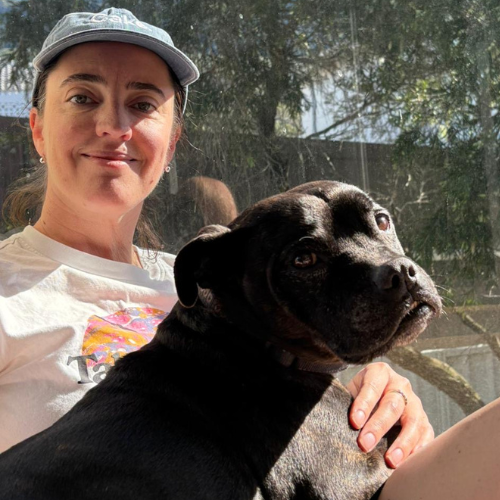
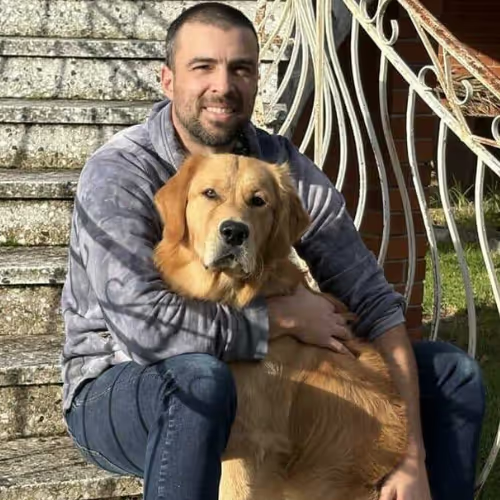
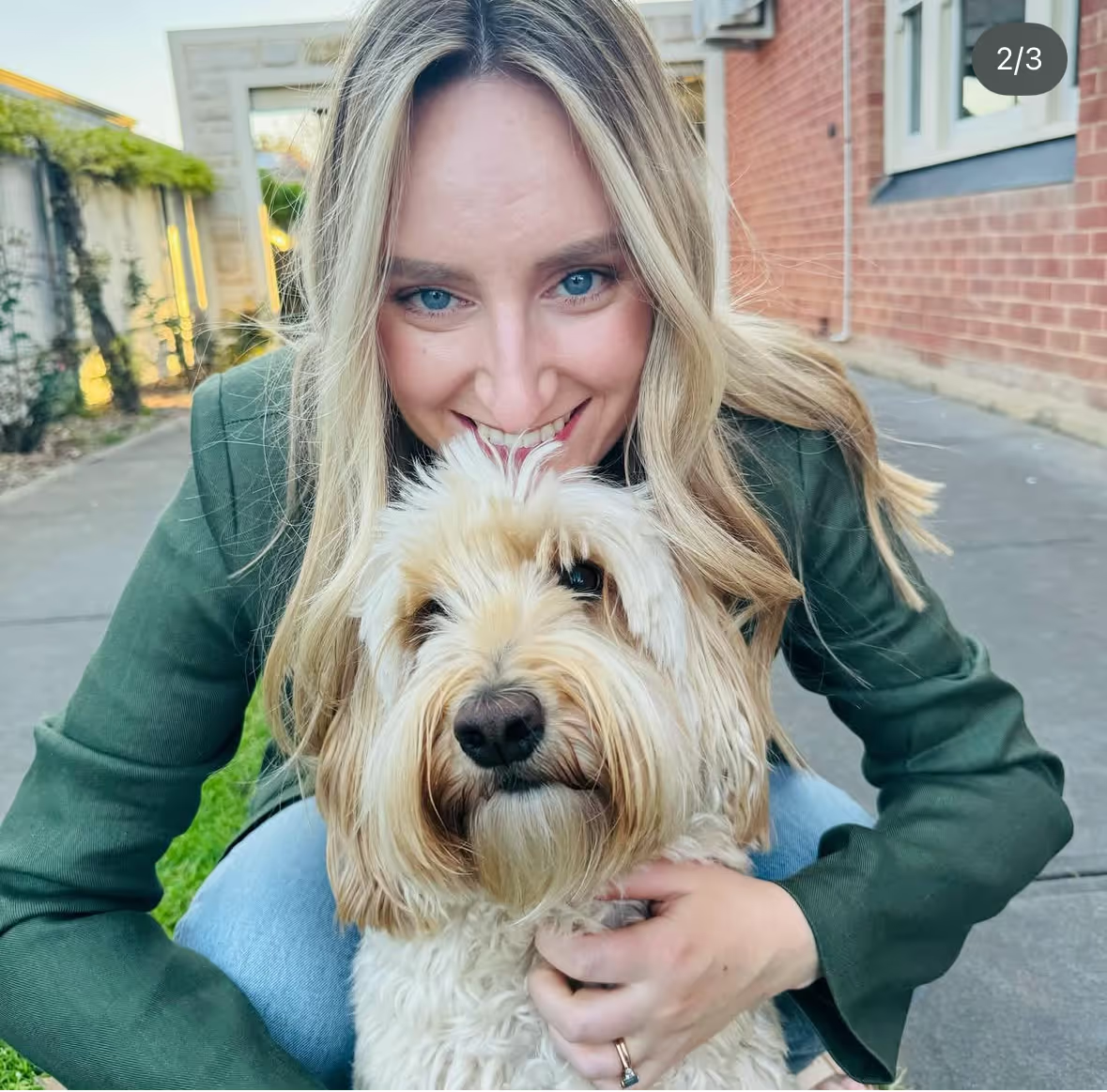
.avif)

